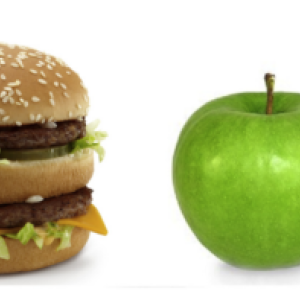
Psychological research has shown that people often don’t make decisions on a rational basis, but rather do so heuristically - based on rules of thumb - that can systematically bias choices. This has important implications when it comes to promoting the sustainable consumption of food.
The results of this study report on a new type of perceptual bias named ‘the negative footprint illusion’ by the study’s authors - this is when the environmental footprint of a green and non-green food product put together is perceived to be lower than just the non-green product alone, despite the fact that this would necessitate the environmental footprint of the green food product to be negative.
This has relevant implications for promoting sustainable food consumption, because the negative footprint illusion could lead to consumers underestimating the environmental impact of their food purchases when these purchases include products that are perceived to be green. Worse, consumers might even deliberately consume more in a misguided effort to reduce their impact. Another negative outcome, is that marketers could use the effect in order to greenwash group-buy offers, by bundling high-footprint foods with organically labelled foods, in order to make offers seem more environmentally friendly than they really are. The authors emphasise that regulators, consumers and competitors need to be aware of this, if they are to counter its effects.
The psychological mechanism behind this was not investigated in the study, but has previously been identified for an analogous bias observed in the field of nutrition - ‘the negative calorie illusion’. The effect stems from the finding that mentally, people place different foods into categories with either positive or negative valence -for example healthy (+) or unhealthy (-), or green (+) or environmentally harmful (-). As a result of this mental accounting, the combination of positive and negative foods is perceived to be better than just negative foods alone, leading to an irrational evaluation of a combination of foods healthiness or green attributes. This overall perception is then used as a rule of thumb and combined with knowledge that low-calorie meals are typically healthier or that low environmental footprint foods are better for the environment, resulting in a systematic underestimation of calories or environmental footprint.
In order to test the hypothesis applied food’s environmental footprint, four experiments were conducted via online surveys, with two different experimental designs. In each case, the environmental footprint metric used was the carbon footprint.
The first three experiments asked the research subjects to rate the environmental footprint of one of three different food groupings: purchases for a main-meal only (potatoes, steak and mushrooms), a main-meal plus organic side (organically labeled salad), or a main-meal plus non-organic side (packaged sauce). Two experiments demonstrated the effect as expected, while a further experiment with a smaller sample size failed to reach statistical significance.
For the first two experiments, the results showed that on average, consumers provide a lower footprint estimates for a main meal combined with an organic apple than for the exact same main meal alone (i.e., without the organic apple). In contrast, when estimating footprints of combinations of a main meal combined with another, non-sustainable side, consumers correctly report higher footprints for the combination than for the stand-alone main meal.
The fourth experiment differed from the first three, in that research subjects were made to evaluate the environmental footprints of each set of foods sequentially, some without the side dish, some with the organic variety of the side dish, and others with the non-organic variety of the side dish. Under this condition, the negative footprint illusion effect was no longer detected, as the additive effect of the environmental footprint when making comparisons, was more readily ascertained.
Abstract
The current research introduces the negative footprint illusion: Although adding a green to a non-green food product necessarily increases total environmental impact (footprint), consumers will sometimes erroneously estimate the total environmental impact of the combination of the green and non-green product lower than the same non-green product alone. The negative footprint effect is demonstrated in two between-subjects survey experiments among consumers responsible for purchases in their household (N = 536, N = 580), is partially supported in a student sample (N = 219), but does not show up in a within-subject experiment (N = 477). Our findings contribute to the understanding of how consumers deal with environmental impact information and how such information can be subject to biased processing. We relate our findings to the broader literature on heuristic processing, as well as to the concepts of green-washing and compensatory green beliefs, and draw implications for research and policy making.
Citation
Gorissen, K. and Weijters, B. (2016). The negative footprint illusion: Perceptual bias in sustainable food consumption. Journal of Environmental Psychology, 45, pp.50-65.
Read the full paper here (paywall)
You can read related research by browsing the following categories of our research library: Consumer stage; Consumption and diets; Certification schemes; Carbon footprinting; Specific behaviour and practice theories
And through the keyword categories: Carbon footprint; Carbon labelling; Consumer perceptions & preferences; Food consumption; Marketing.












Post a new comment »